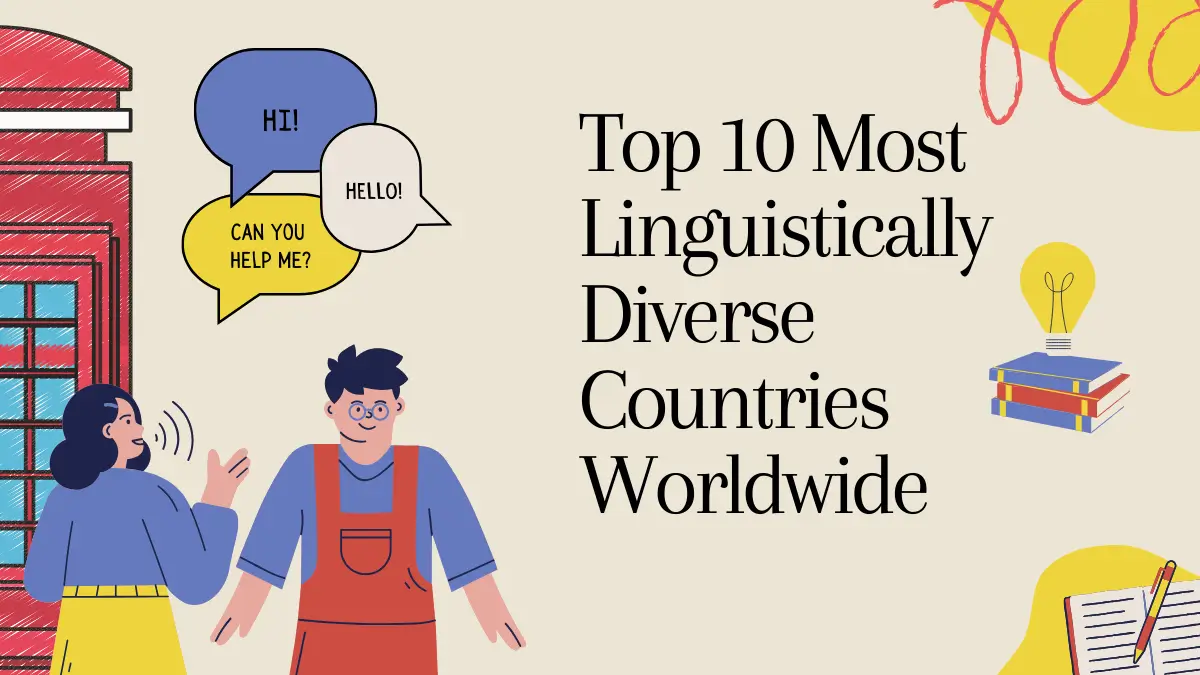Language is one of the most defining aspects of cultural identity. While the world recognizes 23 major languages that account for over half of the global population, there are over 8,324 living languages spoken across the world, according to UNESCO. Some countries exhibit exceptional linguistic diversity, meaning they house hundreds of different languages within their borders.
What is Linguistic Diversity?
Linguistic diversity refers to the number of languages spoken in a specific geographical region or country. It is influenced by historical, geographical, and social factors. Nations with higher linguistic diversity often have multiple indigenous languages, dialects, and minority languages spoken alongside the official language(s).
In this article, we explore the top 10 most linguistically diverse countries in the world as of 2024 and examine the reasons behind their rich linguistic landscapes.
Top 10 Countries with the Most Living Languages (2024)
Based on data from Our World in Data (2024), here are the top ten countries with the most living languages:
| Rank | Country | No. of Living Languages (2024) |
|---|---|---|
| 1 | Papua New Guinea | 840 |
| 2 | Indonesia | 710 |
| 3 | Nigeria | 530 |
| 4 | India | 453 |
| 5 | China | 306 |
| 6 | Mexico | 293 |
| 7 | Cameroon | 279 |
| 8 | United States | 236 |
| 9 | Australia | 224 |
| 10 | Brazil | 222 |
1. Papua New Guinea – The Most Linguistically Diverse Country
Papua New Guinea ranks #1 as the most linguistically diverse nation, with 840 living languages spoken across the country. The primary reasons behind its rich linguistic heritage include:
- Geographical Isolation: Around 87% of the population lives in rural areas, leading to linguistic separation.
- Tribal Culture: Numerous tribes and clans maintain their distinct languages and dialects.
- Official Languages: Tok Pisin, English, Hiri Motu, and Papua New Guinean Sign Language are officially recognized.
2. Indonesia – 710 Living Languages
Indonesia, with its 17,000+ islands, has over 710 spoken languages. The country’s linguistic diversity is attributed to:
- Geographical fragmentation, isolating different communities.
- Indigenous cultures that continue to preserve their linguistic heritage.
- Official Language: Bahasa Indonesia serves as a unifying language.
3. Nigeria – 530 Living Languages
Nigeria is Africa’s most linguistically diverse country, housing 530 languages, including:
- Major languages like Hausa, Yoruba, and Igbo.
- Hundreds of ethnic languages spoken by different communities.
- English as the official language, facilitating communication across diverse regions.
4. India – 453 Living Languages
India is renowned for its rich linguistic diversity, with 453 living languages spoken across its states. Major factors include:
- Cultural and ethnic diversity, spanning multiple regions.
- 22 Official Languages recognized under the Eighth Schedule of the Constitution, including Hindi, Tamil, Bengali, Telugu, and Marathi.
- Hundreds of regional dialects and indigenous languages, making India one of the most multilingual countries globally.
Official Languages of India
The Constitution of India recognizes 22 scheduled languages, including: Assamese, Bengali, Bodo, Dogri, Gujarati, Hindi, Kannada, Kashmiri, Konkani, Maithili, Malayalam, Manipuri, Marathi, Nepali, Odia, Punjabi, Sanskrit, Santali, Sindhi, Tamil, Telugu, and Urdu.
5. China – 306 Living Languages
Although Mandarin Chinese is the dominant language, China houses 306 living languages, largely due to:
- Ethnic minorities such as the Uyghurs, Tibetans, and Mongols.
- Multiple dialects of Mandarin and Cantonese spoken across regions.
- Historical and geographical diversity, leading to linguistic variations.
6. Mexico – 293 Living Languages
Mexico’s linguistic diversity comes from its indigenous communities, with over 293 languages spoken, including:
- Spanish as the official language.
- Indigenous languages like Nahuatl, Mixtec, and Zapotec.
- Cultural preservation efforts to keep native languages alive.
7. Cameroon – 279 Living Languages
Cameroon is one of Africa’s most linguistically diverse nations, featuring:
- Over 270 indigenous languages alongside French and English, its official languages.
- A mix of Bantu, Semi-Bantu, and Chadic languages.
8. United States – 236 Living Languages
Despite English being the dominant language, the United States has 236 spoken languages, including:
- Spanish, Chinese, and Tagalog spoken by large immigrant communities.
- Indigenous languages like Navajo and Cherokee.
- Diverse linguistic representation due to immigration.
9. Australia – 224 Living Languages
Australia’s linguistic diversity stems from:
- Indigenous Australian languages, many of which are endangered.
- Immigrant communities speaking languages like Italian, Greek, and Mandarin.
- English as the official language, but with a strong multilingual culture.
10. Brazil – 222 Living Languages
Brazil’s linguistic landscape is shaped by:
- Portuguese as the dominant language.
- Hundreds of indigenous languages, including Guarani and Tupian.
- Immigrant languages from European and Asian communities.
Countries with the Least Linguistic Diversity
On the other end of the spectrum, some countries have very few spoken languages, such as:
- Falkland Islands (English only)
- Maldives (Dhivehi as the sole official language)
- North Korea (Korean as the only language)



 Which Country is Known as the Land of Ch...
Which Country is Known as the Land of Ch...
 Which Bird is known as the King of Birds...
Which Bird is known as the King of Birds...
 Which City of Austria is Known as the Ci...
Which City of Austria is Known as the Ci...







